A TV program carried out an experiment to answer this question. In the experiment, a lead bullet accurately hit the edge of firmly-fastened sword's blade. The result was that the sword slashed the bullet into two. However, the sword was outdone by a machine gun with bullets for anti-materiel rifle. The sword slashed the first six bullets of the gun, but the other bullets clapped out the sword.
In the bunraku play Uzuki no Iroage(卯月の潤色, Redyeing of Uzuki) by Chikamatsu Monzaemon, the heroine's soul is afraid the corpse of her surviving husband might be used to test the sharpness of swords after being executed. In those days, survivors of love suicide supposed to be executed.
In the Edo Period, the corpses of beheaded criminals were often used to test the sharpness of swords. Swordmakers stamped their names on the blades of their swords. The test results like "cut off two corpses" or "cut off three corpses" were also often inscribed on the blades. A sword made by Seki no Kanefusa(関兼房) has the inscription that a sword tester cut off stacked seven corpses with the sword in 1681. Testers were also excellent swordmen.
Japanese sword has both flexibility and rigidity. A key to unlocking the secret of the sword is a specialized Japanese steel called tama-hagane(玉鋼).
An ancient Japanese ironworks called Tatara(鑪 or 踏鞴) appears in the animated film Princess Mononoke directed by Hayao Miyazaki. In the beginning "Tatara" meant a foot bellows, and it came to include furnaces and ironworks. Tatara iron making method dates back well over a millenary.
While the iron making using iron ore was introduced to Japan from the Korean Peninsula in the 6th century, iron had already been made from iron sand in Izumo area in Shimane Prefecture independently. In Tatara steelmaking method, iron sand and charcoal are mixed together in a clay furnace. The method was completed in the mid-18th century.
The ironworks in the film is much bigger than the real one existed in Izumo. Women blow a bellows in the film, but men did in fact.
A furnace-lighting ceremony was held at the Nittoho Tatara(日刀保たたら) ironworks on January 22. The ironworks operates only for three weeks a year in winter. There are two ironmaking methods using tatara furnace. Steel is produced directly from the iron sand at the ironworks. The other way is directed toward producing pig iron.
Twelve tatara operators including two chief engineers did 70-hour long work three times during the period from January 22 to February 8.
 |
| Nittoho Tatara photo by Shimane Prefectural Tourism Federaion |
With each work, the operators alternately throw iron sand and charcoal into a clay furnace (1 meter wide, 3 meters long and 1.2 meters high) every half hour, and 2.5 tons of a mass of steel called kera is acquired from 10-ton iron sand and 12-ton charcoal. Kera includes tama-hagane, pig iron, another types of iron and steel.
 |
| Nittoho Tatara photo by Shimane Prefectural Tourism Federaion |
After the work, the operators break down the furnace and bring out kera.
 |
| Nittoho Tatara photo by Shimane Prefectural Tourism Federaion |
Kera is broken into some pieces and are sorted out. The best portions will become tama-hagane. The pieces include zuku(pig iron) with carbon content over 1.7%. One-half or one-third of kera is tama-hagane which is rated using a 4-point scale. Kera includes top-grade 100-kg tama-hagane.
The pieces other than tama-hagane are remelted, folded lengthwise and forged to increase their viscosity, beat impurities out of them, equalize the distribution of carbon content. They are formed into hocho-tetsu(wrought iron) with carbon content 0.1-0.3%, sage-hagane (steel) with carbon content about 0.7%. Zuku is used as material for cast metal, hocho-tetsu, sage-hagane. Tama-hagane has a carbon content of 1% to 1.5%.
Iron made in a tatara furnace including tama-hagane contains extremely low chemical impurities such as phosphorus and sulfur. Some people consider charcoal as a possible cause. Phosphorus and sulfur contained in steel, even in trace amounts, make steel brittle. As a fuel, western-style iron making uses coke, and tatara-based iron making does charcoal. Coke has more phosphorus and sulfur than charcoal does. However, the oxygen converter process made it possible to reduce phosphorus and sulfur and to make low-carbon steel.
Some people speculates that silicon dioxide contained in the clay furnace also increases the viscosity of tama-hagane.
Compared with modern steel, Japanese steel (tama-hagane) manufacturing through tatara iron making is also high in oxygen content, and iron slag(the non-metal inclusion) found in the steel contains more oxide-based inclusions which are extremely soft and are easily stretched. By repeatedly forging the steel, the oxide-based inclusions are finely dispersed.
This makes Japanese swords strong, increases their viscosity, produces blade patterns on them, and makes them easier to be ground. Normally, non-metal inclusions are a nuisance to steel. However, they are considered as a positive factor in making Japanese steel.
This makes Japanese swords strong, increases their viscosity, produces blade patterns on them, and makes them easier to be ground. Normally, non-metal inclusions are a nuisance to steel. However, they are considered as a positive factor in making Japanese steel.
Japanese sword
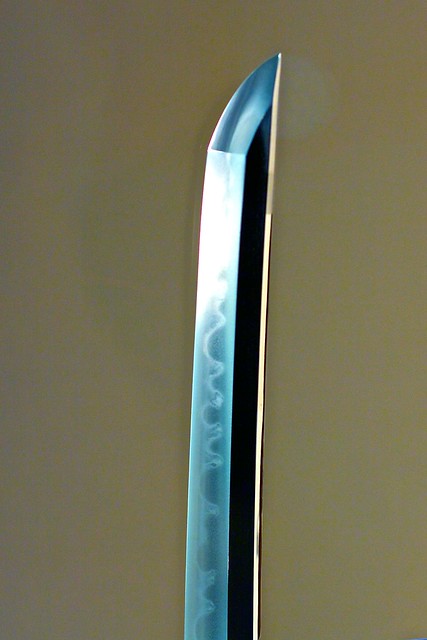 |
| MetAug 37 - Version 2 by Dan Culleton /flickr |
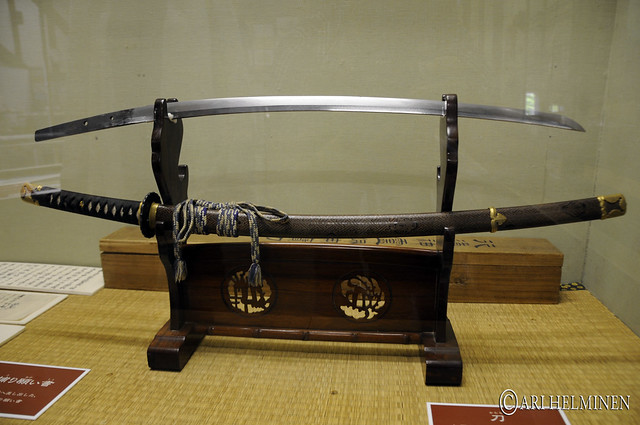 |
| Katana 刀 by Ari Helminen flickr |
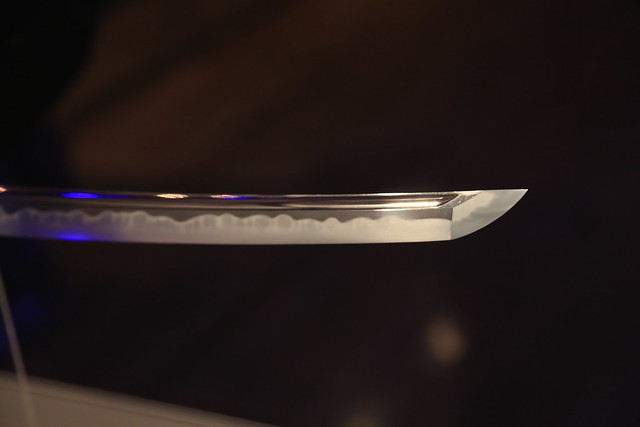 |
| 大和ミュージアム by Norio.NAKAYAMA /flickr |
Swordsmiths combine one or two kinds of Japanese steel together to adjust the carbon content during the forging process, and several kinds of steel are created. Japanese swords were made up of 2-4 kinds of steel having different carbon content: soft steel with carbon content about 0.3%(the core of sword), hard steel with carbon content about 0.8%(the blade edge), hard steel(the spine of sword), medium steel with carbon content about 0.6%(both sides of blade).
They include almost no chemical elements other than iron and carbon, so they can be forge welded without flux. Japanese forged cutting tools are produced by mechanical alloying.
 |
Japanese sword smiths, Akimori Miyagi(宮城昭守) and his son Norizane Miyagi(宮城典真)
in Shiraishi City, Miyagi Prefecture
photo by Miyagi Prefectural Tourism Division
|
The tools heated to over 800 degrees Celsius is quenched not in oil, but in water. Only part of edge can be hardened through heating. Heated normal steel gets cracked by quenching in water. The forged cutlery is an alloy of steels with different carbon concentrations, so it prevents the cutlery from cracking.
 |
| photo by Miyagi Prefectural Tourism Division |
Uchihamono(打刃物, forged iron cutting tools) in Nakaniida(中新田), Kami-machi, Miyagi Prefecure
It is said that a swordsmith started it there in the late 17th century. Nakaniida's forged iron cutlery such as knife, sickle is made with the same method as Japanese swords.
Tatara-based iron making cpmpleted in the mid-18th century is only one of ironmaking methods. The ancient swords produced during the Kamakura Period(1185-1333) and the the Northern and Southern Courts period(1334-1392) are considered the highest-grade swords, but it's unclear how they were made. They were made of soft steel, but they are sharper than swords made in other periods. Their blades are composite of several kinds of steel due to primitive iron making methods. Japanese swords have been meant to be a work of art since tama-hagane(hard steel) came to be used in sword-making in the Edo Period, a warless period.
Osafune(?) made in the 15th century at the Tokyo National Museum
The Society for Preservation of Japanese Art Swords(日本美術刀剣保存協会) runs Nittoho Tatara, and the employees of Hitachi Metals Yasugi Works operate it. Several swordsmiths and researchers have small tatara furnaces, but it seems to be difficult to make perfect steel.
This traditional method has a low yield rate. It is ill-suited to mass production. Tatara-based iron making had gone into a gradual decline since the introduction of western-style iron making method in the late 19th century. Its commercial production ended in 1925.
The Society for Preservation of Japanese Art Swords rebuilt the Nittoho tatara ironworks with support from the Agency for Cultural Affairs to provide Japanese steel to Japanese sword smiths in Okuizumo, Shimane Prefecture in 1977.
Only about 300 swordsmiths licensed by the Agency for Cultural Affairs are allowed to make Japanese swords, and each swordsmith is permitted to make two sword a month.
All traditional swords made in Japan have to be registered with a local prefectural government. Japanese swords with Torokusho(registration certificate) are available.
The owners of five tatara ironworks in Okuizumo(奥出雲) and Hoki(伯耆) established the Unpaku Steel Limited Partnership Company(雲伯鉄鋼合資会社) to manufacture and sell tatara products in a district near Yasugi Harbor, Shimane Prefecture in 1899. This later became Hitachi Metals Yasugi Works.
Hitachi Metals used modern technologies to develop Yasugi Specialty Steel(YSS) with the unique characteristics (i.e., the purity) of Japanese steel.
The company is one of suppliers of steel strips for razor blades. It is said that YSS accounted for 60-70% in the world market of razor blade steel and was supplied to razor makers such as Gillette, Schick, Wilkinson in the mid-2000s. Some people say its current world market share makes about 40-65%, but I'm not really sure about it.
In Japan, most Japanese cuisine cheffs use a knife with YSS blade, and many professional-quality cutting tools have YSS blades.
In 2014, the exhibition will take place at Maison de la culture du Japon à Paris, Paris, France from April 30 to June 21, at Museo ABC, Madrid, Spain from July 5 to September 28.
"Lance of Longinus”appears in Evangelion
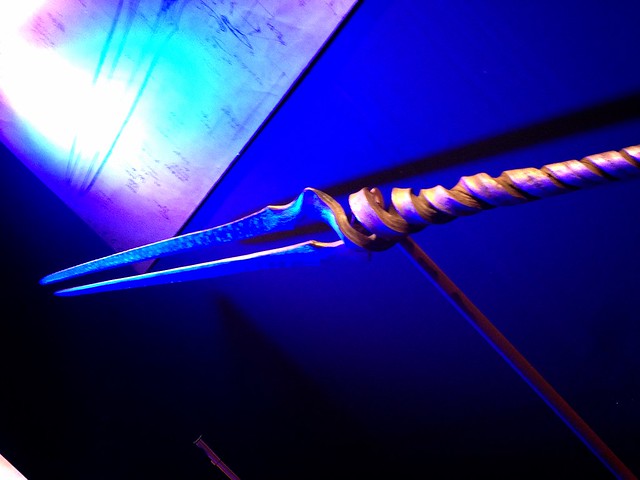 |
| 2013-03-22 by Norio.NAKAYAMA /flickr |
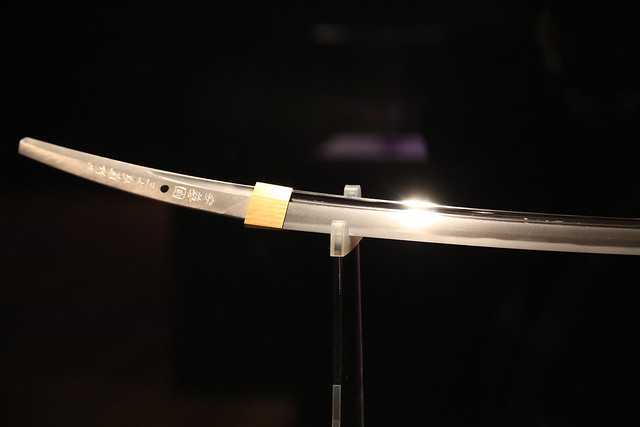

No comments:
Post a Comment